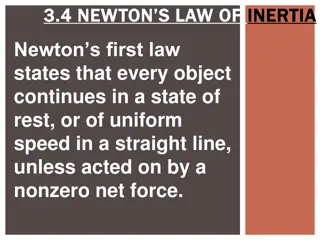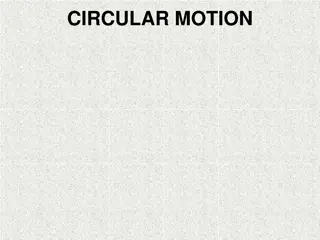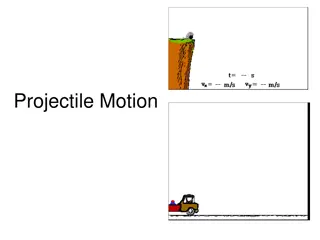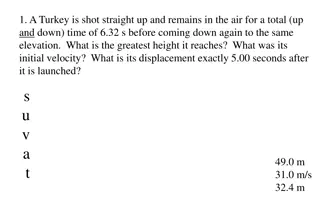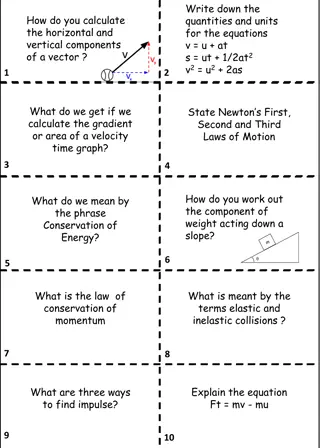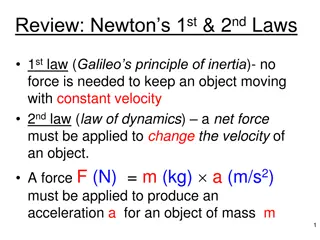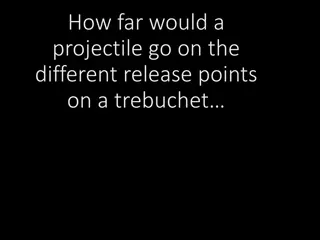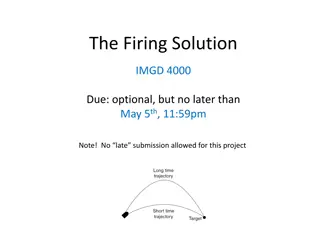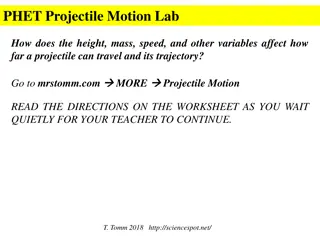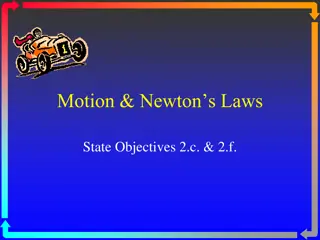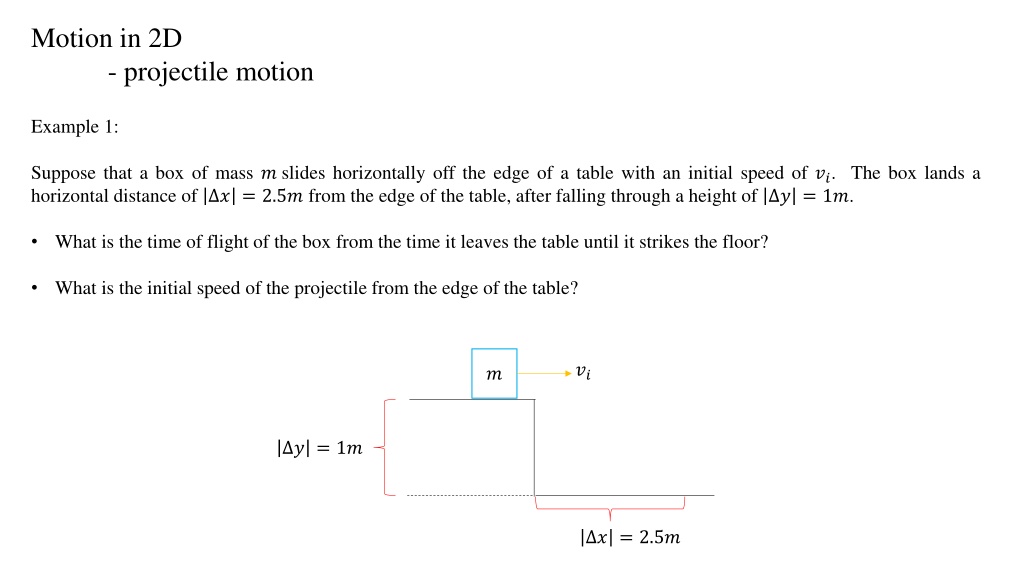
Projectile Motion Examples and Applications in 2D
Explore various examples of projectile motion in 2D scenarios, including a sliding box, basketball shot, thrown quarter, and cartoon coyote chase. Understand concepts like time of flight, initial speed, trajectory, and impact velocity in different scenarios.
Uploaded on | 2 Views
Download Presentation

Please find below an Image/Link to download the presentation.
The content on the website is provided AS IS for your information and personal use only. It may not be sold, licensed, or shared on other websites without obtaining consent from the author. Download presentation by click this link. If you encounter any issues during the download, it is possible that the publisher has removed the file from their server.
E N D
Presentation Transcript
Motion in 2D - projectile motion Example 1: Suppose that a box of mass ? slides horizontally off the edge of a table with an initial speed of ??. The box lands a horizontal distance of ? = 2.5? from the edge of the table, after falling through a height of ? = 1?. What is the time of flight of the box from the time it leaves the table until it strikes the floor? What is the initial speed of the projectile from the edge of the table? ?? ? ? = 1? ? = 2.5?
Motion in 2D - projectile motion Example 2: A basketball player who is 2? tall is standing of the court a distance 10? from the basket. If the ball is shot at a ? = 400 with respect to the horizontal, at what initial speed should the ball be thrown so that it goes through the hoop without striking the backboard? Assume that the basket is 3.05? above the court. What is the time of flight of the ball from it s release until it goes through the hoop? What are the magnitude and direction of the velocity of the ball when it goes through the hoop?
Motion in 2D - projectile motion Example 3: A quarter is thrown from a large building at an upward angle of ? = 300 with respect to the horizontal, with an initial speed of 10? ?. How long does it take the quarter to hit the ground if the building is 45? tall? That is, what is the time of flight of the quarter? How long does it take the quarter to reach maximum height above the building? What is the maximum height the quarter reaches above the top of the building? How far from the base of the building does the quarter land? What are the magnitude and direction of the impact velocity?
Motion in 2D - projectile motion Example 4: Suppose that a cartoon coyote is once again determined to catch an elusive roadrunner. The coyote is wearing a pair of AcmeTM powered jet roller skates with provide a constant horizontal acceleration of 15? 70? from the edge of a cliff at the instant the roadrunner zips past in the direction of the cliff. ?2. The coyote starts off from rest What minimum speed would the roadrunner need to have to beat the coyote to the cliff? At the edge of the cliff the roadrunner escapes by making a sudden turn, while the coyote continues straight off the cliff. Unfortunately, as soon as the coyote leaves the cliff his skates turn off. If the cliff is 100? above the canyon floor, where does the coyote land with respect to the edge of the cliff? If the coyote s skates continued to work when the coyote went off the cliff, now how far from the edge of the cliff would the coyote land? Assume the coyote s skates remain horizontal as the coyote falls. What would be the components of the impact velocity in each case above?
Motion in 2D - projectile motion Example 5: The islands of Hawaii are a beautiful place to live and a great vacation spot, boasting lush tropical forests, pristine beaches, and an active volcano. In 2018 the volcano Kilauea was actively erupting on the big island of Hawaii. Some residents were trying to defend their homes from active lava flows and from lava bombs. In fact, a man made the news in May 2018 after he was hit by a lava bomb trying to save his home. Lava bombs are solid chunks of rock ejected from a volcano. Consider a schematic of a volcano, shown on the right, with a lava bomb being ejected. With what magnitude of the initial velocity, at the top of the volcano, would the lava bomb have to have for a lava bomb to land at the base of the volcano? What would be the time of flight of this lava bomb from the top of the volcano to its base? What is the final velocity of the lava bomb, expressed as a magnitude and direction, just before the lava bomb hits the ground at the base? What is the acceleration of the lava bomb just before it hits the ground at the base?
Motion in 2D - projectile motion Example 6: A game of battleship. Suppose that an enemy ship is on the western side of a mountain and that the enemy ship can maneuver to within 2500? of the 1800? high mountain peak. The enemy ship can shoot projectiles with an initial speed of 250? the peak, what are the distances from the eastern shoreline at which a friendly ship can be in order to be safe from being hit by an enemy projectile? ? oriented at some angle ? measured with respect to the horizontal. If the eastern shoreline is horizontally 300? from
Motion in 2D - projectile motion Example 7: Base jumping is apparently a thrilling but dangerous sport in which the participant jumps off of a very tall building or structure, free-falls for a while, and then opens a parachute and glides gently to the ground. Suppose that you run horizontally off a very tall cliff with a speed of 4? vertically for 750?? ?. How long are you in free fall if you fall After you have fallen vertically a distance of 750?, you open your parachute. How far horizontally from the edge of the cliff are you when you open your parachute? Just before you open your parachute, what was your free fall velocity in both magnitude and direction? Ideally parachutists try to land around 20?? components of their impact velocity. However, suppose in this case that after you open your parachute you lose the horizontal component of your velocity and that you float straight down to the ground below at 9? you bend your legs so that you come to rest over a larger distance than if you landed stiff legged on the ground. If your body decelerates to rest over 0.45? by bending your legs, what magnitude of upward force does the ground impart on your if your mass is 60??? ?with this speed being a combination of their horizontal and vertical ?~9? ?. When you land,





